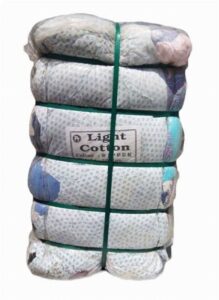Light Cotton Waste Product Description
Light cotton waste is a byproduct generated during the cotton processing industry. It consists of short fibers, lint, and other remnants that are not suitable for spinning into yarn or fabric. This waste material is typically lightweight, soft, and highly absorbent, making it a versatile resource for various applications. The cotton waste is often collected from spinning mills, garment factories, and textile processing units. Due to its natural properties, light cotton waste is biodegradable and environmentally friendly, making it an attractive option for sustainable practices.
Uses of Light Cotton Waste
Light cotton waste has a wide range of applications across different industries, including:
- Textile Industry: Used as stuffing material for pillows, cushions, and toys.
- Cleaning Products: Ideal for making rags, wipes, and cleaning cloths due to its absorbent nature.
- Insulation Material: Can be used in insulation for buildings and vehicles.
- Composting: Serves as a natural composting material, enriching soil quality.
- Crafts and DIY Projects: Popular among crafters for making handmade items, such as quilts and fabric art.
- Medical Applications: Utilized in the production of bandages and other medical supplies due to its softness and absorbency.
Technical Data
| Property | Description |
|---|---|
| Material Type | Light Cotton Waste |
| Color | Natural white or off-white |
| Weight | Approximately 100-200 grams per cubic meter |
| Moisture Content | 8-10% |
| Fiber Length | Short fibers (1-2 inches) |
| Absorbency | High (up to 25 times its weight in water) |
| Biodegradability | Fully biodegradable |
| Applications | Cleaning, insulation, stuffing, crafts, composting, medical supplies |
| Packaging | Typically packaged in bales or bags |
| Storage Conditions | Store in a cool, dry place to prevent mold and degradation |
Light cotton waste is a valuable resource that not only helps reduce waste in the textile industry but also provides numerous benefits across various sectors. Its versatility and eco-friendliness make it an excellent choice for sustainable practices.

